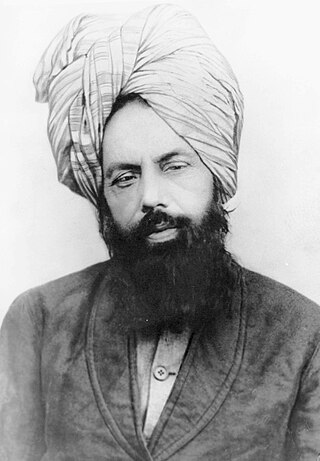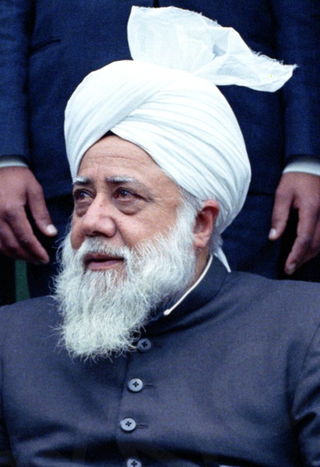
MirzāGhulām Aḥmad was an Indian religious leader and the founder of the Ahmadiyya movement in Islam. He claimed to have been divinely appointed as the promised Messiah and Mahdī—which is the metaphorical second-coming of Jesus (mathīl-iʿIsā), in fulfillment of the Islamic prophecies regarding the end times, as well as the Mujaddid of the 14th Islamic century.

The Lahore Ahmadiyya Movement for the Propagation of Islam, is a separatist group within the Ahmadiyya movement that formed in 1914 as a result of ideological and administrative differences following the demise of Hakim Nur-ud-Din, the first Caliph after Mirza Ghulam Ahmad. Members of the Lahore Ahmadiyya movement are referred to by the majority group as ghayr mubāyi'īn and are also known colloquially as Lahori Ahmadis.

The Ahmadiyya Caliphate is a non-political caliphate established on May 27, 1908 following the death of Mirza Ghulam Ahmad, the founder of the Ahmadiyya Muslim Community, who claimed to be a Prophet, a Messenger, the promised Messiah and Mahdi, the expected redeemer awaited by Muslims. It is believed by Ahmadis to be the re-establishment of the Rashidun Caliphate that commenced following the death of the Islamic prophet Muhammad. The caliphs are entitled Khalīfatul Masīh, sometimes simply referred to as Khalifa. The caliph is the elected spiritual and organizational leader of the worldwide Ahmadiyya Muslim Community and is the successor of Ghulam Ahmad. He is believed by the Community to be divinely ordained and is also referred to by its members as Amir al-Mu'minin and Imam Jama'at. The 5th and current Caliph of the Messiah of the Ahmadiyya Community is Mirza Masroor Ahmad.

Qadian is a city and a municipal council in Gurdaspur district, north-east of Amritsar, situated 18 kilometres (11 mi) north-east of Batala city in the state of Punjab, India. Qadian is the birthplace of Mirza Ghulam Ahmad, the founder of the Ahmadiyya movement within Islam. It remained the headquarters of the Ahmadiyya movement until the Partition of India in 1947.

Mirza Nasir Ahmad was the third Caliph of the Ahmadiyya Muslim Community. He was elected as the third successor of Mirza Ghulam Ahmad on 8 November 1965, the day after the death of his predecessor and father, Mirza Basheer-ud-Din Mahmood Ahmad.

Mirza Basheer-ud-Din Mahmood Ahmad was the second caliph, leader of the worldwide Ahmadiyya Muslim Community and the eldest son of Mirza Ghulam Ahmad from his second wife, Nusrat Jahan Begum. He was elected as the second successor of Mirza Ghulam Ahmad on 14 March 1914 at the age of 25, the day after the death of his predecessor Hakim Nur-ud-Din.

Hakeem Noor-ud-Din was a close companion of Mirza Ghulam Ahmad, the founder of the Ahmadiyya Movement, and his first successor and first Ahmadiyya caliph since 27 May 1908.

The Fazl Mosque also known as The London Mosque, is the first purpose-built mosque in London, England. It was opened on 23 October 1926 in Southfields, Wandsworth. At a cost of £6,223, the construction of the mosque and the purchase of the land on which it stands, was financed by the donations of Ahmadi Muslim women in Qadian, Punjab, British India, with support from the British Muslim convert Khalid Sheldrake. Between 1984 and 2019 the Fazl Mosque was the residence of the caliphs of the Ahmadiyya Muslim Community, and therefore its de facto international headquarters. The administrative headquarters now lies at the site of the Islamabad, Tilford.

Mirza Masroor Ahmad is the current and fifth leader of the Ahmadiyya Muslim Community. His official title within the movement is Fifth Caliph of the Messiah. He was elected on 22 April 2003, three days after the death of his predecessor Mirza Tahir Ahmad.

Ahmadiyya, officially the Ahmadiyya Muslim Community or the Ahmadiyya Muslim Jama'at, is an Islamic revival or messianic movement originating in British India in the late 19th century. It was founded by Mirza Ghulam Ahmad (1835–1908), who claimed to have been divinely appointed as both the Promised Mahdi and Messiah expected by Muslims to appear towards the end times and bring about, by peaceful means, the final triumph of Islam; as well as to embody, in this capacity, the expected eschatological figure of other major religious traditions. Adherents of the Ahmadiyya—a term adopted expressly in reference to Muhammad's alternative name Aḥmad—are known as Ahmadi Muslims or simply Ahmadis.

Jalsa Salana is a formal, annual gathering of the Ahmadiyya Muslim Community. It was initiated in 1891 by Mirza Ghulam Ahmad, the founder of the community, in Qadian, India. Usually, the gathering spans three days, beginning with the flag hoisting ceremony following the Friday Sermon. Although the convention held in the UK is deemed to be the major and 'international Jalsa' attended by Ahmadis from across the world, Ahmadis in other countries hold their own national Jalsas, sometimes attended by the Khalifatul Masih.

Ahmadiyya is an Islamic branch in Indonesia. The earliest history of the community in Indonesia dates back to the early days of the Second Caliph, when during the summer of 1925, roughly two decades prior to the Indonesian revolution, a missionary of the Community, Rahmat Ali, stepped on Indonesia's largest island, Sumatra, and established the movement with 13 devotees in Tapaktuan, in the province of Aceh. The Community has an influential history in Indonesia's religious development, yet in the modern times it has faced increasing intolerance from religious establishments in the country and physical hostilities from radical Muslim groups. The Association of Religion Data Archives estimates around 400,000 Ahmadi Muslims, spread over 542 branches across the country.
Bahishti Maqbara, located originally in Qadian, India, and then in Rabwah, Pakistan, is a religious cemetery established by the Ahmadiyya Community as a directive from the community's founder Mirza Ghulam Ahmad, made known in his booklet Al-Wasiyyat. Mirza Ghulam Ahmad established it in his will after he saw an angel showing him the place of his burial.

Ahmadiyya is a growing minority Islamic sect in Bangladesh. Although the first Bengalis to join the sect did covert during the lifetime of Mirza Ghulam Ahmad, the sect was first established as a community in the region of Bengal in 1913 by Syed Muhammad Abdul Wahed, during the Caliphate of Hakeem Noor-ud-Din. As the worldwide community is itself is an highly organised group under the Caliph, the national community works under the name Ahmadiyya Muslim Community Bangladesh or Ahmadiyya Muslim Jama'at Bangladesh. There are an estimated 100,000 Ahmadis in the country as of 2004.

The Ahmadiyya Muslim Community was established in United Kingdom with the pioneering efforts of Chaudhry Fateh Muhammad Sial, who arrived in London in July in 1913. Sial was the first missionary sent overseas by the Ahmadiyya Muslim Community and was under the direction of Hakeem Noor-ud-Din, the first caliph of the movement.
The word Mirzai is a religious slur used to refer to Ahmadis by many South Asian Muslims, primarily in Pakistan where they have been persecuted from early days and specially after the passage of Second Amendment to the Constitution of Pakistan which declares that Ahmadia are not Muslims and Ordinance XX. Ahmadis are the followers of Mirza Ghulam Ahmad of Qadian.

Ahmadiyya is an Islamic branch in Spain, under the spiritual leadership of the caliph in London. The earliest history of the Community in Spain dates back to the period of the Second Caliph, when Malik Mohammad Sharid Gujrati, a missionary of the Community, arrived in Madrid on March 10, 1936. However, in the same year the Spanish Civil War broke out forcing Gujrati to abandon the country. Missionary efforts commenced once again following the Second World War, in 1946 when Karam Ilahi Zafar was sent by the caliph. The Basharat Mosque in Pedro Abad, built by the Ahmadiyya in the 1980s is the first mosque to be built in Spain since the Fall of Granada and the end of Muslim rule at the end of the 15th century. Today there are two purpose-built Ahmadi Muslim mosques and roughly 500 adherents in Spain.

Ahmadiyya is an Islamic branch in Denmark, under the spiritual leadership of the caliph in London. Kamal Yousuf, an Ahmadi Muslim missionary, who was appointed for disseminating Ahmadiyya teachings in Scandinavia, first toured Denmark in 1956. The earliest Danes to have converted to the movement were from the 1950s and the Community was first established in 1959, during the last few years of the Second Caliphate. Today, there are two Ahmadi mosques, of which one is purpose-built mosque, the oldest in the country. There are an estimated 600 Ahmadi Muslims in the country.

Ahmadiyya is an Islamic community in Afghanistan, under the leadership of the caliph in London. The earliest contact with the Ahmadiyya movement in Islam and the Pashtun people within modern-day boundaries of Afghanistan, occurred during the lifetime of Mirza Ghulam Ahmad. The movement began by Ahmad, was largely seen as apostasy by most other Muslim groups, including by those in Afghanistan, and accordingly only twelve years after Ahmad's claim to be the promised Mahdi, two of the foremost Ahmadi Muslims were stoned to death in Kabul during 1901 to 1903. The killings continued until 1925, when in 1924–1925, under Emir Amanullah Khan, affiliation with Ahmadiyya beliefs became a capital offence and those who converted were forcibly reverted.
















